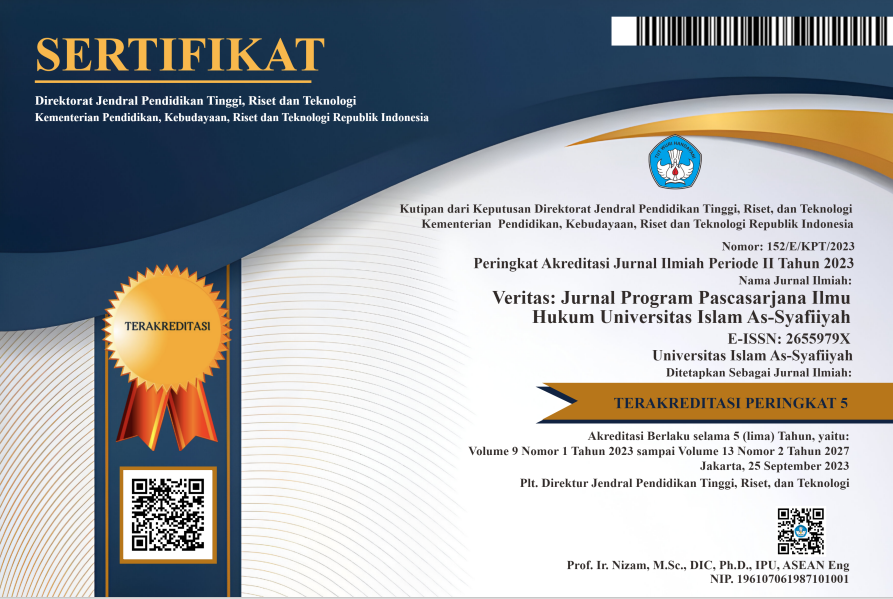LEGAL ASPECT OF FOREST FIRE IN INDONESIA
Abstract
This study to examine legal aspect, why always happen and impact of forest fire in Indonesia. The conclusion are, even though there is a forestry law as regulated in Law No. 41/1999 on Forestry, as amended by Law Number 19/2004, forest fires have been repeated several large scale since the early 1980s until now. The case of Indonesia which was experiencing forest fires is a manifestation of unclear and poorly enforced policies, economic forces that push business to use fire to clear land, lack of technological alternatives, poor public participation and aggravated by climatic condition such as the extended drought. Although many policies have already been formulated and special management agencies have been established, policies implementation remain weak, coordination is poor and the current system is inefficient. Added to these factors, is the reality that government official’s business leader and general public lack a sense of urgency about the fires. Fires can impede national economic performance and increase poverty at the local level. It is mostly that disaster until now will repeat/recur unless definitive steps are taken to encourage short term and long term prevention strategies. Fires cause tremendous ecological impacts such as air quality, hydrological cycle, biological diversity, natural succession, disruption of the production and decomposition of organic materials, soil, disruption in the nutrient cycle, climate regulation and carbon sink; social impact such as food security, impact on health such as death, asthma, ARI, and impact on economic such as, agriculture, forestry, health, transmigration, transportation and tourism.
References
Central Bureau of Statistic, 1997. “Indonesia Figure 1997”, Central Bureau of Statistic, Indonesia.
Central Bureau of Statistic, State Ministry of Population-National Family Planning Coordinating Board, Ministry of Health, and Demographic and Health Surveys Macro International Inc, 1997. “INDONESIA DEMOGRAPHIC AND HEALTH SURVEY, 1997”.
CIC, 1997. “Study about Indonesia’s Industry and Oil Palm Plantation”. PT. Capricorn Indonesia Consult Inc. Jakarta.
Directorate General of Forest Protection and Nature Conversation 1997. “Compilation of Decrees on Fire Suppression”.
EEPSEA and WWF, 1998. “The Indonesia Fires and Haze of 1997: The Economic Toll”. Economic and Environment Program for SE Asia and the World Wide Fund for Nature (WWF), 29 May 1998.
FFPCP 1997. “Wild Fire Occurrence and Causes in the three FFPCP Pilot Areas in 1996-1997. (Project Report No. 13D)”. Government of Indonesia Ministry of Forestry-European Union-European Commission-Natural Resources Institute-Cirad-Forest BCEOM-SCOT CONSEIL.
Goldhammer J.G. 1997. “Forest Fire and Smoke Management and Policy Issues in Indonesia and Neighboring Countries of South East Asia”. Paper presented at the International Workshop on National Guidelines on the Protection of Forest against Fires, Bogor, 8-9 December 1997.
http://sipongi.menlhk.go.id/hotspot/luas_kebakaran
http://pubdocs.worldbank.org
ITCI, 1997. “Field Visit Report of Fires Area in Logging Concession/Forest Product Concession”. ITCI.
Kompas Nespaper, September 29, 1994.
Kompas Newspaper, October 1, 1994.
Kompas Newspaper, October 5, 1994.
Kompas Newspaper, October 7, 1994.
Law Number 41 of 1999 concerning Forestry, as amended by Law Number 19/2004.
Ministry of Environment and United Nation Development Program, 1997. “Agenda 21 Indonesia”.
Ministry of Environment and UNDP, 1998. “Forest and Land Forest in Indonesia, Impacts, Factors and Evaluation”, Volume I, September 1998.
Pangestu M, and M. Ahmad, 1998. “ASEAN Regional Cooperation on Haze”. Memorandum ASEAN Economic Forum.
Primack, RB, J. Supriatna, and P.Karmadibrata, 1998. “Biology Conservation”. Obor Foundation, Jakarta.
Ramon, J, 1993. “Forest Inventory of the Participatory Forest Management Area; General Description, Classification and Stratification of the Inventory Plots”. SFTDP, GTZ Report, Sanggau, Kalimantan – Indonesia.
Schindele, W, W. Thoma, and K. Panzer, 1998. “The Forest Fire 1983/1984 in East Kalimantan, Part I: The Fire, The Effects, The Damage and Technical Solution. Investigation of the Steps Need to Rehabilitate the Areas of East Kalimantan Seriously Affected by Fire”. FR_Project, ITTO, GTZ, BPPK, and DRFS.
Siswanto, W, Hudiyono and Sukirman E, 1993. “Forest and Fire in Indonesia, In: A State of Art Report on Some Report Forestry Policies, Initiatives and Achievements in Indonesia”. Ministry of Forestry of the Republic of Indonesia, Jakarta.
SKEPHI, 1992. “Special Report on Forest Fire”. Setiakawan No. 7, January – June 1992, Jakarta.
Suara Pembaruan Newspaper, September 29, 1994.
United Nation, 1996. “World Population Data Prospects: the 1996 Revision”.




